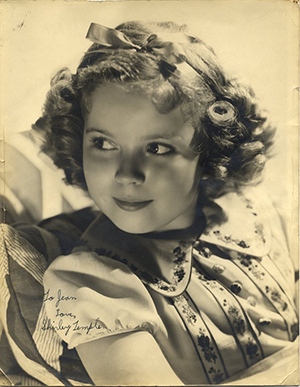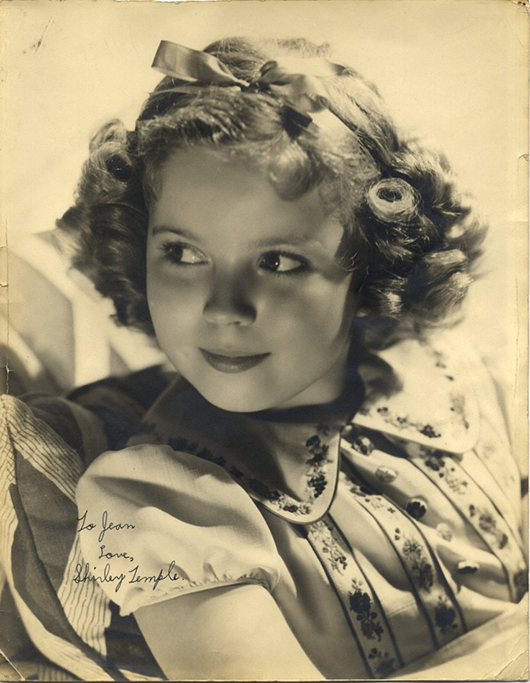
Temple, who died Monday night at 85, sang, danced, sobbed and grinned her way into the hearts of dispirited Depression-era moviegoers and remains the ultimate child star decades later. Other pre-teens, from Macaulay Culkin to Miley Cyrus, have been as famous in their time. But none of them helped shape their time the way she did.
Dimpled, precocious and oh-so-adorable, she was America’s top box office draw during Hollywood’s golden age, and her image was free of the scandals that have plagued Cyrus, Lindsay Lohan and so many other child stars – parental feuds, or drug and alcohol addiction.
Temple remains such a symbol of innocence that kids still know the drink named for her: a sweet, nonalcoholic cocktail of ginger ale and grenadine, topped with a maraschino cherry.
Her hit movies – which included Bright Eyes (1934), Curly Top (1935), Dimples (1936), Poor Little Rich Girl (1936) and Heidi (1937) – featured sentimental themes and musical subplots, with stories of resilience and optimism that a struggling American public found appealing. She kept children singing On the Good Ship Lollipop for generations.
She was also a tribute to the economic and inspirational power of movies, credited with helping to save 20th Century Fox from bankruptcy and praised by President Franklin D. Roosevelt himself for lifting America’s spirits during a gloomy time.
She was “just absolutely marvelous, greatest in the world,” director Allan Dwan told filmmaker-author Peter Bogdanovich in his book Who the Devil Made It: Conversations With Legendary Film Directors.
“With Shirley, you’d just tell her once and she’d remember the rest of her life,” said Dwan, who directed her in Heidi and Rebecca of Sunnybrook Farm. “Whatever it was she was supposed to do – she’d do it. … And if one of the actors got stuck, she’d tell him what his line was – she knew it better than he did.”
Her achievements did not end with movies. Retired from acting at 21, she went on to hold several diplomatic posts in Republican administrations, including ambassador to Czechoslovakia during the sudden collapse of communism in 1989.
Former President George H.W. Bush, who appointed Black to the post in Prague, saluted her Tuesday for “her selfless service to our country” and her film career.
“In both roles, she truly lifted people up and earned not only a place in our hearts, but also our enduring respect,” Bush said in a statement.
Temple, known in private life as Shirley Temple Black, died at her home near San Francisco. The cause of death was not disclosed.
From 1935 to 1938, she was the most popular screen actress in the country and was a bigger draw than Clark Gable, Joan Crawford or Gary Cooper. In 1999, the American Film Institute’s ranking of the greatest screen legends put Temple at No. 18 among the 25 actresses.
“I have one piece of advice for those of you who want to receive the lifetime achievement award: Start early,” she quipped in 2006 as she was honored by the Screen Actors Guild.
But she also said that evening that her greatest roles were as wife, mother and grandmother: “There’s nothing like real love. Nothing.” Her husband of more than 50 years, Charles Black, had died a few months earlier.
In Bright Eyes, Temple introduced the song On the Good Ship Lollipop and did battle with a charmingly bratty Jane Withers, launching Withers as another major child star. As a bright-eyed orphan in Curly Top, she sang Animal Crackers in My Soup.
She was teamed with the legendary dancer Bill “Bojangles” Robinson in two 1935 films with Civil War themes, The Little Colonel and The Littlest Rebel. Their tap dance up the steps in The Little Colonel (at a time when interracial teamings were rare in Hollywood) became a landmark in the history of film dance.
Known for a remarkable ability to cry on cue, she won a special Academy Award at age 6 – and was presented with a miniature Oscar statuette – for her “outstanding contribution to screen entertainment.”
Temple and her movies were an escapist delight at a time when America was down in the dumps.
Mothers dressed their little girls like her, and a line of dolls that are now highly sought-after collectibles was launched. Her fans seemed interested in every last golden curl on her head. Her mother, Gertrude, was said to have done her hair for each movie, with every hairstyle having exactly 56 curls.
Roosevelt once said: “As long as our country has Shirley Temple, we will be all right. When the spirit of the people is lower than at any other time during this Depression, it is a splendid thing that for just 15 cents, an American can go to a movie and look at the smiling face of a baby and forget his troubles.”
Temple’s mother worked to keep her daughter from being spoiled by fame and was a constant presence during filming. Temple said years later that her mother had been furious when a director once sent the mother off on an errand and then got the child to cry for a scene by frightening her. “She never again left me alone on a set,” Temple said.
But Temple also suggested that in some ways, she grew up too soon. She stopped believing in Santa Claus at age 6, she once said, when “Mother took me to see him in a department store and he asked for my autograph.”
Decades later, her interest in politics brought her back into the spotlight.
She made an unsuccessful bid for Congress as a Republican in 1967. After Richard Nixon became president in 1969, he appointed her a member of the U.S. delegation to the U.N. General Assembly. In the 1970s, she was U.S. ambassador to Ghana and later U.S. chief of protocol.
A few months after she arrived in Prague in 1989, communist rule was overthrown in Czechoslovakia as the Iron Curtain collapsed across Eastern Europe.
“My main job (initially) was human rights, trying to keep people like future President Vaclav Havel out of jail,” she said in a 1999 Associated Press interview. Within months, she was accompanying Havel, the former dissident playwright, when he came to Washington as his country’s new president.
She considered her background in entertainment an asset to her political career.
“Politicians are actors too, don’t you think?” she once said. “Usually if you like people and you’re outgoing, not a shy little thing, you can do pretty well in politics.”
Born in Santa Monica, Calif., to an accountant and his wife, Temple was little more than 3 when she made her film debut in 1932 in the Baby Burlesks, a series of short films in which tiny performers parodied grown-up movies, sometimes with risque results.
Temple’s expert singing and tap-dancing in the 1934 movie Stand Up and Cheer! first gained her wide notice.
Her 1942 film Miss Annie Rooney included her first on-screen kiss, bestowed by another maturing child star, Dickie Moore.
Her appeal faded as quickly as it had emerged. She missed a shot at playing Dorothy in The Wizard of Oz when 20th Century Fox chief Darryl Zanuck refused to lend out his greatest asset; the part went to Judy Garland. And The Little Princess in 1939 and The Blue Bird in 1940 didn’t draw big crowds, prompting Fox to let Temple go.
Among her later films were The Bachelor and the Bobby-Soxer, with Cary Grant, and That Hagen Girl, with Ronald Reagan.
After her film career ended, she concentrated on raising her family and turned to television to host and act in 16 specials called Shirley Temple’s Storybook on ABC. In 1960, she joined NBC and aired The Shirley Temple Show.
Her 1988 autobiography, Child Star, was a best-seller.
Temple married Army Air Corps Pvt. John Agar, the brother of a classmate at Westlake, her exclusive Los Angeles girls’ school, in 1945. He took up acting and the pair appeared together in two films, Fort Apache and Adventure in Baltimore. She and Agar had a daughter, Susan, in 1948. The actress filed for divorce the following year.
She married Black in 1950, and they had two more children, Lori and Charles. That marriage lasted until his death in 2005 at age 86.
In 1972, she underwent surgery for breast cancer and was credited with opening up public discussion about the disease. She issued a statement urging other women to get checked by their doctors and vowed: “I have much more to accomplish before I am through.”
___
Associated Press writers Martha Mendoza and Matt Reed contributed to this report.
Copyright 2014 Associated Press. All rights reserved. This material may not be published, broadcast, rewritten, or redistributed.
AP-WF-02-11-14 2138GMT
ADDITIONAL IMAGE OF NOTE


